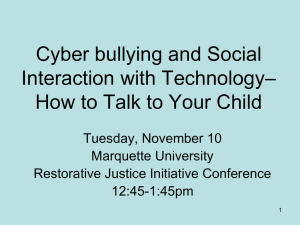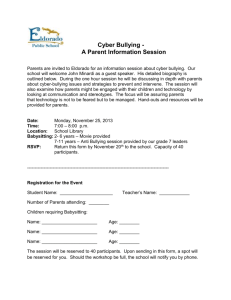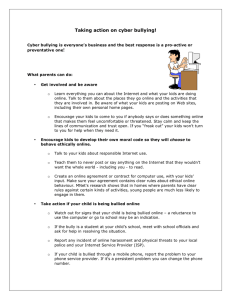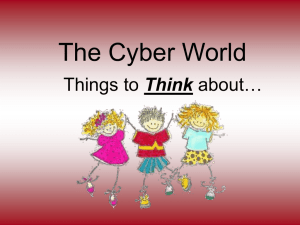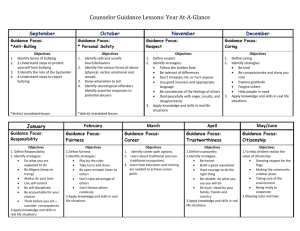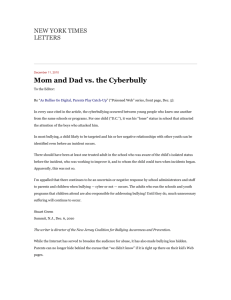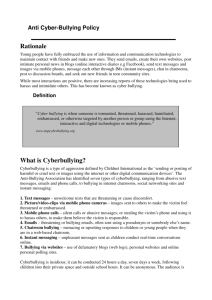108 Cyberbullying - City of Greater Geelong
advertisement
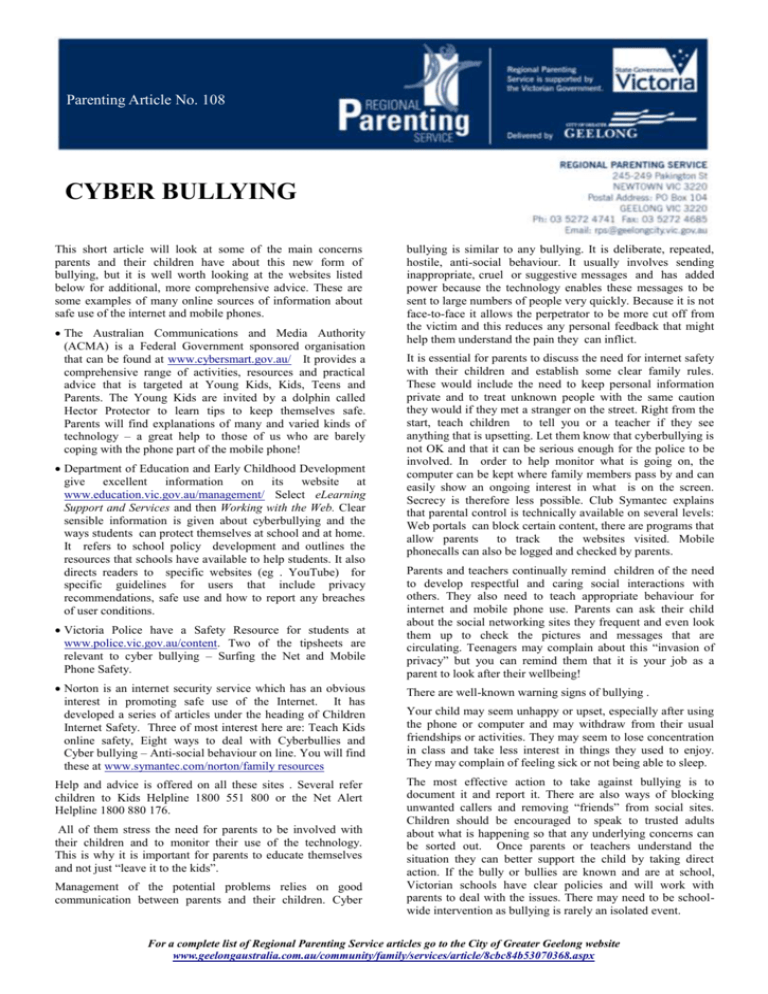
Parenting Article No. 108 CYBER BULLYING This short article will look at some of the main concerns parents and their children have about this new form of bullying, but it is well worth looking at the websites listed below for additional, more comprehensive advice. These are some examples of many online sources of information about safe use of the internet and mobile phones. The Australian Communications and Media Authority (ACMA) is a Federal Government sponsored organisation that can be found at www.cybersmart.gov.au/ It provides a comprehensive range of activities, resources and practical advice that is targeted at Young Kids, Kids, Teens and Parents. The Young Kids are invited by a dolphin called Hector Protector to learn tips to keep themselves safe. Parents will find explanations of many and varied kinds of technology – a great help to those of us who are barely coping with the phone part of the mobile phone! Department of Education and Early Childhood Development give excellent information on its website at www.education.vic.gov.au/management/ Select eLearning Support and Services and then Working with the Web. Clear sensible information is given about cyberbullying and the ways students can protect themselves at school and at home. It refers to school policy development and outlines the resources that schools have available to help students. It also directs readers to specific websites (eg . YouTube) for specific guidelines for users that include privacy recommendations, safe use and how to report any breaches of user conditions. Victoria Police have a Safety Resource for students at www.police.vic.gov.au/content. Two of the tipsheets are relevant to cyber bullying – Surfing the Net and Mobile Phone Safety. Norton is an internet security service which has an obvious interest in promoting safe use of the Internet. It has developed a series of articles under the heading of Children Internet Safety. Three of most interest here are: Teach Kids online safety, Eight ways to deal with Cyberbullies and Cyber bullying – Anti-social behaviour on line. You will find these at www.symantec.com/norton/family resources Help and advice is offered on all these sites . Several refer children to Kids Helpline 1800 551 800 or the Net Alert Helpline 1800 880 176. All of them stress the need for parents to be involved with their children and to monitor their use of the technology. This is why it is important for parents to educate themselves and not just “leave it to the kids”. Management of the potential problems relies on good communication between parents and their children. Cyber bullying is similar to any bullying. It is deliberate, repeated, hostile, anti-social behaviour. It usually involves sending inappropriate, cruel or suggestive messages and has added power because the technology enables these messages to be sent to large numbers of people very quickly. Because it is not face-to-face it allows the perpetrator to be more cut off from the victim and this reduces any personal feedback that might help them understand the pain they can inflict. It is essential for parents to discuss the need for internet safety with their children and establish some clear family rules. These would include the need to keep personal information private and to treat unknown people with the same caution they would if they met a stranger on the street. Right from the start, teach children to tell you or a teacher if they see anything that is upsetting. Let them know that cyberbullying is not OK and that it can be serious enough for the police to be involved. In order to help monitor what is going on, the computer can be kept where family members pass by and can easily show an ongoing interest in what is on the screen. Secrecy is therefore less possible. Club Symantec explains that parental control is technically available on several levels: Web portals can block certain content, there are programs that allow parents to track the websites visited. Mobile phonecalls can also be logged and checked by parents. Parents and teachers continually remind children of the need to develop respectful and caring social interactions with others. They also need to teach appropriate behaviour for internet and mobile phone use. Parents can ask their child about the social networking sites they frequent and even look them up to check the pictures and messages that are circulating. Teenagers may complain about this “invasion of privacy” but you can remind them that it is your job as a parent to look after their wellbeing! There are well-known warning signs of bullying . Your child may seem unhappy or upset, especially after using the phone or computer and may withdraw from their usual friendships or activities. They may seem to lose concentration in class and take less interest in things they used to enjoy. They may complain of feeling sick or not being able to sleep. The most effective action to take against bullying is to document it and report it. There are also ways of blocking unwanted callers and removing “friends” from social sites. Children should be encouraged to speak to trusted adults about what is happening so that any underlying concerns can be sorted out. Once parents or teachers understand the situation they can better support the child by taking direct action. If the bully or bullies are known and are at school, Victorian schools have clear policies and will work with parents to deal with the issues. There may need to be schoolwide intervention as bullying is rarely an isolated event. For a complete list of Regional Parenting Service articles go to the City of Greater Geelong website www.geelongaustralia.com.au/community/family/services/article/8cbc84b53070368.aspx
